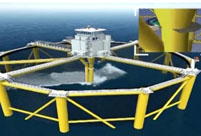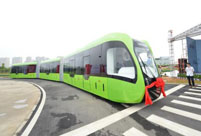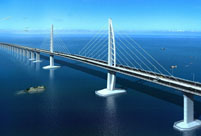

China's foreign trade expanded at its fastest pace since the second half of 2011, buffering the economy from a slowdown amid headwinds at home and abroad.
Exports in yuan-denominated terms rose 15 percent year on year in the first half of this year while imports increased 25.7 percent, customs data showed Thursday.
That led to a trade surplus of 1.28 trillion yuan (188 billion U.S. dollars) in the same period, down 17.7 percent year on year, according to the General Administration of Customs.
Total foreign trade volume reached 13.14 trillion yuan in H1, up 19.6 percent year on year, the quickest pace since the second half of 2011.
The brisk growth was bolstered by a lower comparison basis, government support and healing global demand, Huang Songping, a spokesperson with the customs authority, told a press briefing.
During the first six months, trade with the EU jumped 17.4 percent from the same period last year. The EU is China's biggest trade partner, accounting for 14.8 percent of the country's foreign trade.
Meanwhile, trade with the United States and ASEAN went up by 21.3 percent and 21.9 percent, respectively.
Private business played an overwhelming role in foreign trade with export and import value up 20.6 percent to 5.02 trillion yuan in the first half, or 38.2 percent of the nation's total.
Most of China's exports were machinery, electronics and labor-intensive products, with their export value accounting for 57.2 percent of the total.
However, Huang brought attention to a tough stance on foreign trade in the second half of this year due to a higher comparison basis, uncertainties in the global environment and deep-seated problems in the domestic economy.
Uncertainties weigh on the global market as major economies practice divergent monetary policy. Commodity prices and trade protectionism also add unpredictability.
As developed economies shore up advanced manufacturing and emerging economies strengthened on low production costs, China's exports are due to face more fierce competition in the global market.
"Looking ahead, we expect export growth to slow on uncertainties in external demand due to rising geopolitical risks, and the renminbi's stronger exchange rate against the U.S. dollar in H1 2017," according to a report by Nomura Securities.
Import growth is also likely to moderate along with export growth. The cooling property market is likely to lead to slower domestic investment growth, which may also weigh on import growth, she added.
But Huang Songping reaffirmed the view that the strong fundamentals of China's foreign trade have not changed. They will continue with good momentum, and the trade structure will be improved if no major risks arise.
China's economy grew 6.9 percent in the first quarter of the year, up from 6.8 percent the previous quarter and above the government's annual target of around 6.5 percent for 2017.
Regarding China's trade with the Democratic People's Republic of Korea (DPRK), Huang said surging trade volume in H1 was driven by China's exports of labor-intensive products that are not on the United Nations' embargo list.
"As close neighbors, China and the DPRK maintain normal trade," Huang said.
He played down the significance of aggregate data in the first half and highlighted the fact that China's imports from the DPRK had fallen substantially for four straight months since March.
Following the UN Security Council's resolutions, China had banned imports of coal from the DPRK since mid-February. In the first half of this year, coal imports from the DPRK dwindled 74.5 percent year on year to 2.68 million tonnes.
"China has always abided by the rules of the United Nations resolution on a trade embargo with the DPRK ... It is a common responsibility of all UN members. China will carry out the practice in a consistent, accurate and stringent way," Huang said.
 Magnificent view of Nansha Islands in South China Sea
Magnificent view of Nansha Islands in South China Sea Aerial view shows scenery in Hong Kong
Aerial view shows scenery in Hong Kong China builds world’s first offshore fish farm
China builds world’s first offshore fish farm A Foreigner's Chinese Dream and Love for China
A Foreigner's Chinese Dream and Love for China 5,000-year-old Chinese beer recipe goes down a storm in US
5,000-year-old Chinese beer recipe goes down a storm in US World's first driverless rail transit system unveiled in Hunan
World's first driverless rail transit system unveiled in Hunan World's largest cluster of Miao villages in Guizhou
World's largest cluster of Miao villages in Guizhou Daily life in Kashgar, China's Xinjiang
Daily life in Kashgar, China's Xinjiang Top 10 Chinese tech and engineering marvels
Top 10 Chinese tech and engineering marvels Top 10 most sustainable cities in China
Top 10 most sustainable cities in China Top 10 European patent applicants in 2016
Top 10 European patent applicants in 2016 The power of 'She' in China
The power of 'She' in China Seven most beautiful art museums in China
Seven most beautiful art museums in China Clock ticking for Guo Wengui to face justice
Clock ticking for Guo Wengui to face justiceDay|Week